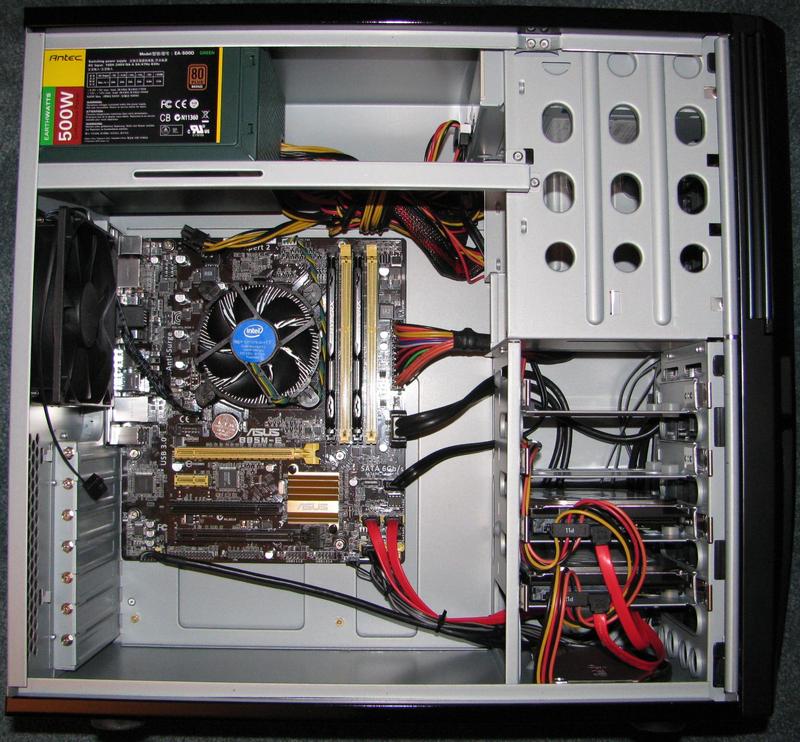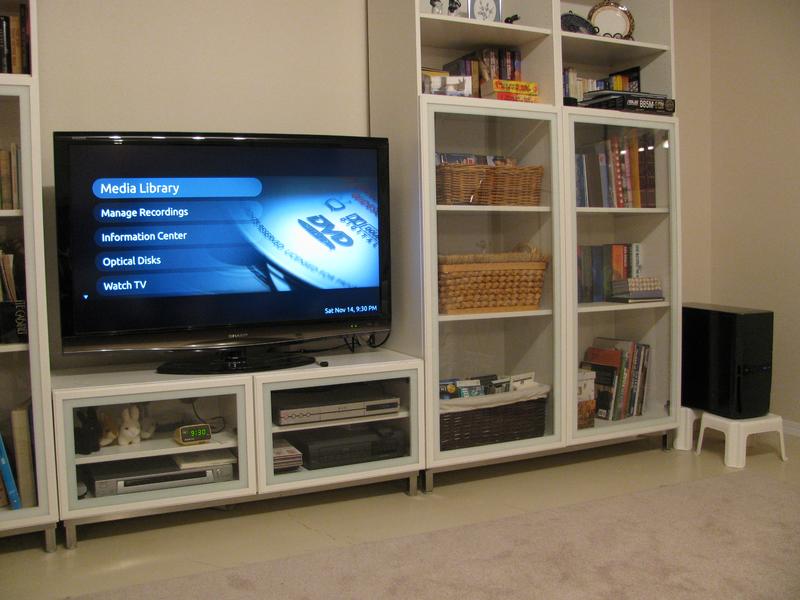
Building MythTV PVR with HDHomeRun Network Tuner
Summary
This article describes the hardware I selected to build a PVR using a
network based tuner in the Fall of 2015.
Previously I built three identical Personal Video Recorders in Spring
2011 and these continue to run well. Recently another family member
requested a PVR. Now that it is four years later, a few challenges
arise because some hardware is no longer available or the hardware has
changed. As a result of these challenges, I wrote this updated
article covering hardware selection and Mythbuntu 14.04 installation
steps.
Contents
- Selecting Hardware
- 2015 PVR Component List
- PVR Internals
- Installing Mythbuntu
- Install Complete
- Completed PVR
- References
Selecting Hardware
Back in Spring 2011 I wrote Selecting Hardware for a MythTV PVR. Now that it is the Fall of 2015 I have written this updated article.
When selecting the hardware, it is a good idea to have some goals to help guide decisions. For this PVR we desired the following features:
- Must be quiet (PVR directly attached to TV)
- Must be both MythTV Backend (record) and Frontend (play)
- Must support recording at least 2 shows at once
- Must have TV show listings
- Must be able to watch and burn DVDs
- Must support PVR in basement with TV antenna upstairs
- Should keep options open for future upgades
Following are the hardware components chosen.
TV Tuner/Video Capture
You have to start somewhere when building a computer so for the PVR I started with choosing a TV Tuner.
There are a variety of TV Tuners available (network connected, USB connected, motherboard connected). To find one compatible with MythTV, see MythTV Digital Tuner Cards. The LinuxTV hardware device information website is also helpful. This is an area where searching the Internet can provide more up-to-date information and personal experiences from others.
Since this PVR was to be placed in a basement and the TV antenna
needed to be on the main floor, I did not want to suffer from TV
signal degradation over a long coax cable. Hence I eliminated the
internal card and USB connected tuner devices. This left network
connected TV tuners allowing the tuner to be placed right beside the
antenna and then connected to the PVR by an Ethernet cable. Using the
goal of recording at least two shows at once guided me toward my
choice.
SiliconDust
HDHomeRun CONNECT (dual tuner) - Cost $150
Case / Power Supply
Cases come in a variety of shapes and styles, such as Home Theater Personal Computer (HTPC), tower (tall), and desktop (wide). The one you choose will depend on the space available near your TV. Since space in the TV cabinet was limited, I chose a tower to stand off to the side.
This is a key component if you wish to keep noise levels low. Common sources of noise come from moving parts in the PC, such as fans and spinning disk drives, and sometimes from the power supply. To limit noise, large fans spinning at a lower rate are quieter than small fans spinning quickly. To further limit noise, it helps to isolate the hard drive from the case. This is often accomplished using rubber grommets. A good quality power supply can also help limit noise.
Due to my good experience with my desktop computer I chose the same
Antec Case.
Antec
Sonata III quiet mid-tower case - Cost $170
This case has proven to be very quiet in operation, has rubber
grommets to isolate spinning hard drives, and includes a quiet 500
Watt power supply.
Processor (CPU)
Since I've had good luck with the Intel quad core processor used in
previous PVRs, I selected a similar processor with built in HD
graphics.
Intel
Core i5-4430 Processor, up to 3.2GHz w/ 6MB Cache (Intel HD 4600
Graphics) - Cost $240
The stock fan on this processor has proven to be quiet so I did not
need to opt for a larger fan CPU cooler.
Motherboard (MB)
There are many motherboard manufacturers out there. When choosing a motherboard it is critical that it fit within the case you select. Since I wanted future upgradability I looked for the following:
- 1 HDMI port (for Intel HD 4600 Graphics to TV)
- 1 slot that could be used for a video card (if discrete video card needed -- it isn't)
- 4+ SATA connections for optical/hard drives
- 4+ USB ports (for keyboard/mouse/remote control)
- 2+ memory slots for RAM chips
Personally I've had good experiences with Gigabyte and ASUS so I
limited my choice to these manufacturers. Since the case would
easily support 4 hard drives and a solid state drive I gravitated
toward a board with 6 SATA ports.
ASUS B85M-E/CSM
Motherboard - Cost $110
The BIOS on this motherboard works well with MythTV automatic startup
and shutdown.
Memory (RAM)
The type of RAM to use is dictated by the motherboard. Since the
motherboard had 4 memory slots, I opted to fill two slots. This led
to my choice.
Kingston
HyperX Fury Black 8GB DDR3-1600MHz CL10 Dual Channel Kit (2x4GB) -
Cost $65
My previous PVRs have shown that a single 4GB RAM DIMM is more than
sufficient. However since the incremental cost to get 8 GB RAM was
low, I went for 2x4GB = 8GB RAM.
Video Card
Personally I've been happy with the integrated graphics in my PVR, so I opted to stick with this option. The processor chosen has Intel HD 4600 Graphics.
Sound Card
Years ago I used SoundBlaster sound cards. Nowadays I find that the built-in sound on the motherboard to be more than sufficient. To save a slot on the motherboard I recommend staying with the onboard sound.
Network Card
Many motherboards now include a wired Ethernet port as is the case with the above chosen motherboard. The PVR will communicate with the network tuner over an Ethernet cable.
Disk Storage
The amount of storage for TV shows is a key factor for how many hours
of recordings the PVR can hold. With this in mind, it is usually
better to go for a larger hard disk drive. From my experience, one
hour of 1080i HDTV video takes up to 9 GB of space.
Because a PVR will typically see much more read and write activity
than a desktop computer, I suggest using a traditional spinning Hard
Disk Drive (HDD) for storing TV shows instead of a Solid State Drive
(SSD). Also the cost for HDDs is significantly less than for SDDs.
I chose two 1 TB hard disk devices to be configured in a RAID to store
the TV show recordings.
Seagate
Barracuda 1TB 7200RPM SATA 6 GB/S - Cost 2 x $80
From past experience I now like to keep the operating system separate
from the PVR recordings. Since small Solid State Drives boot up fast
and are not excessively priced, I chose a 120 GB SSD.
Intel
SSD 535 Series 120GB 2.5in SATA 6 GB/S - Cost $95
Optical Drive (DVD-RW)
With the DVD-RW optical drive, I simply chose an inexpensive one that
would connect to a SATA port.
ASUS 24x
DVDRW SATA DRW-24F1ST - Cost $25
This optical drive works well for watching and also burning DVDs.
Keyboard and Mouse
There are many choices for computer keyboards and mice. Some
keyboards even combine touch pad functionality into the keyboard. To
avoid the clutter of cords, I chose a wireless keyboard with built in
touch pad.
Logitech
K400 Wireless Touch Keyboard - Cost $50
This keyboard is great for couch surfing and short emails, but I would
not use it for extensive typing due to the small non-standard layout.
Remote Control
MythTV supports many remote controls.
See MythTV
Remote Controls.
Since the previous remote controls I chose continue to work well, I made the same choice again.
Rosewill
RRC-126 MCE Remote Control - $30
This remote control includes a USB infrared receiver which easily
plugs into the front of the case, or into a USB extension cord if
needed.
2015 PVR Component List
Following is a list of components and their costs in October 2015.
| Category | Component | Cost |
|---|---|---|
| TV Tuner/Video Capture | SiliconDust HDHomeRun CONNECT (dual tuner) | 150 |
| Case | Antec Sonata III quiet mid-tower case | 170 |
| Power Supply | Included with case (500 Watts) | 0 |
| Processor (CPU) | Intel Core i5-4430 Processor, up to 3.2GHz w/ 6MB Cache (Intel HD 4600 Graphics) | 240 |
| Motherboard (MB) | ASUS B85M-E/CSM Motherboard | 110 |
| Memory (RAM) | Kingston HyperX Fury Black 8GB DDR3-1600MHz CL10 Dual Channel Kit (2x4GB) | 65 |
| Video Card | Included with processor (Intel HD 4600 Graphics) | 0 |
| Sound Card | Included with motherboard (onboard sound) | 0 |
| Network Card | Included with motherboard (onboard Ethernet) | 0 |
| Disk Storage (Recordings) |
Seagate
Barracuda 1TB 7200RPM SATA 6 GB/S Note that 2 drives were purchased for RAID setup - 2 x $80. |
160 |
| Disk Storage (Operating System) | Intel SSD 535 Series 120GB 2.5in SATA 6 GB/S | 95 |
| Optical Drive (DVD-RW) | ASUS 24x DVDRW SATA DRW-24F1ST | 25 |
| Keyboard and Mouse | Logitech K400 Wireless Touch Keyboard | 50 |
| Remote Control | Rosewill RRC-126 MCE Remote Control | 30 |
| Grand Total | $ 1,095 |
The total cost came to $1,230 including tax, assembly, network cables,
coax cables, 3-way coax splitter, 20' HDMI cable, and a 15' USB
extension cable.
The resulting PVR is very quiet, powerful and expandable in the
future.
PVR Internals
Following is a picture of the inside of the PVR.

As can be seen the case provides lots of room for expandability, such
as the addition of extra hard drives, internal tuner cards, and extra
memory.
Installing Mythbuntu
To install Mythbuntu on this PVR I followed the steps in Installing Mythbuntu 14.04.1 with MythTV 0.27 with the following notable changes.
A. Setup BIOS
On the ASUS P85M-E/CSM motherboard I made sure I had the following BIOS settings:
- BIOS at a working level (2202 Feb 13, 2015)
- Ensure SATA set to AHCI mode (default)
- Ensure iGPU Memory set to AUTO (default)
- Ensure Boot Logo Display set to AUTO (default)
- Set Power ON when power restored
- Disable Fast Boot
- Set Secure Boot OS Type to Other OS
- Change boot order to DVD then USB then HDD
Next, continue with B. Partition Drive.
I. Enable Capture Card
No additional firmware is required on the PVR. However, now is a good time to update the firmware on the network connected HDHomeRun CONNECT dual tuner.
- Download the latest firmware for your HDHomeRun
Connect dual tuner
at SiliconDust
Linux Firmware Downloads.
Near the bottom of the web page I used the link named HDHR4-2US (hdhomerun4_atsc) to download the hdhomerun4_atsc_firmware_20150826.bin file.
Be sure to choose the correct link for your model of HDHomeRun tuner.
- Start Applications -> Multimedia -> HDHomeRun
Config GUI.
Select the Device and the Upgrade tab.
Select the firmware file and then click the Upgrade button to load the new firmware.
Note that there is no harm if you do install the Hauppauge firmware onto the PVR from the other tutorial.
X. Configure MythTV Backend
Follow the steps in this section of the other tutorial, but for 2. Capture Cards substitute the following:
2. Capture cards
(New capture card)
Card type: HDHomeRun networked tuner
Available devices: 10416512-0 * <- from pick list
Recording Options
Max simultaneous recordings: 2
(New capture card)
Card type: HDHomeRun networked tuner
Available devices: 10416512-1 * <- from pick list
Recording Options
Max simultaneous recordings: 2
* Note that your HDHomeRun device will have a different number.
The digit after the dash indicates one of the two tuners.
Similarly for 5. Input Connections substitute the following:
5. Input Connections
For ATSC Over-The-Air Antenna:
Choose HDHOMERUN: 10416512-0
Video source: HD Antenna
Name: HDTuner1
Starting Channel: 3_1
Input Priority: 0
Schedule Order: 1 # Ascending order, increment by capture card max simultaneous recordings
Live TV Order: 3 # Descending order, to avoid conflicts with scheduled recordings
Choose HDHOMERUN: 10416512-1
Video source: HD Antenna
Name: HDTuner2
Starting Channel: 3_1
Input Priority: 0
Schedule Order: 3
Live TV Order: 1
After finishing 6. Input Connections, continue with Y. Configure MythTV Frontend.
Installation Complete
Congratulations! You have now completed the steps to setting up an always on PVR that should reboot and work properly after any power outages.
To save on power expenses I followed the steps in Configuring MythTV Automatic Wakeup and Shutdown.
To enable streaming of content over the Internet I also followed the steps in Tear Free Firefox Menu in MythTV.
Completed PVR
Following is a picture of the PVR in operation.

The PVR is shown on the far right of the large screen TV (black tower
on white stand). Not shown is the network connected HDHomeRun CONNECT
dual tuner which is located upstairs near the TV antenna.
References
While setting up this Mythbuntu MythTV PVR, I found the following reference useful:

